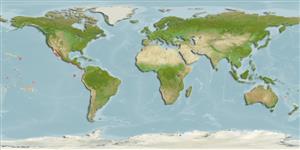Environment: milieu / climate zone / depth range / distribution range
Ecologia
marinhas associadas(os) a recifes. Tropical; 32°N -
Eastern Pacific: throughout Gulf of California south to Peru. Recorded in the Galapagos Islands during the 1982-83 El Niño (Ref. 9405).
Tamanho / Peso / Idade
Maturity: Lm ? range ? - ? cm
Max length : 25.0 cm TL macho/indeterminado; (Ref. 9118); common length : 20.0 cm TL macho/indeterminado; (Ref. 9118)
Descrição suscinta
Chaves de identificação | Morfologia | Morfometria
Body elongate, moderately compressed, and deep, with a strongly arched dorsal profile; snout prominent; mouth small and sub-terminal; lower jaw enclosed by upper; chin with 5 pores but without barbels; edge of preopercle slightly serrate; lower branch of first gill arch with 6 gill rakers; second dorsal fin very long, with 32 to 33 soft rays; body uniformly dark, from purplish bronze to grayish brown; fins dark or blackish (Ref. 55763).
Adults are secretive nocturnal fish that hide under ledges by day and come out only at night to feed on the epifauna of the substrate. The adults sometimes form large inactive aggregations in caves, but little or no feeding occurs. Schools of juveniles appear only in the summer.
Ciclo de vida ou comportamento de acasalamento
Maturities | Reprodução | Spawnings | Egg(s) | Fecundities | Larvas
Chao, L.N., 1995. Sciaenidae. Corvinas, barbiches, bombaches, corvinatas, corvinetas, corvinillas, lambes, pescadillas, roncachos, verrugatos. p. 1427-1518. In W. Fischer, F. Krupp, W. Schneider, C. Sommer, K.E. Carpenter and V. Niem (eds.) Guia FAO para identificacion de especies para los fines de la pesca. Pacifico Centro-oriental. 3 volumes. 1813 p. (Ref. 9118)
Status na Lista Vermelha da UICN (Ref. 130435)
Ameaça para os humanos
Harmless
Uso pelos humanos
Pescarias: pouco comercial; Aquário: Aquários públicos
Ferramentas
Relatórios especiais
Baixar XML
Fontes da internet
Estimates based on models
Preferred temperature (Ref.
123201): 20.6 - 29.1, mean 25.1 °C (based on 236 cells).
Índice de diversidade filogenética (Ref.
82804): PD
50 = 0.5078 [Uniqueness, from 0.5 = low to 2.0 = high].
Bayesian length-weight: a=0.00851 (0.00413 - 0.01752), b=3.08 (2.91 - 3.25), in cm total length, based on LWR estimates for this (Sub)family-body shape (Ref.
93245).
Nível Trófico (Ref.
69278): 3.5 ±0.37 se; based on food items.
Resiliência (Ref.
120179): Elevada, tempo mínimo de duplicação da população menor que 15 meses (Preliminary K or Fecundity.).
Fishing Vulnerability (Ref.
59153): Low vulnerability (15 of 100).
Nutrients (Ref.
124155): Calcium = 70.8 [36.4, 114.2] mg/100g; Iron = 0.672 [0.340, 1.125] mg/100g; Protein = 19.5 [18.2, 20.9] %; Omega3 = 0.154 [0.084, 0.231] g/100g; Selenium = 35.3 [21.3, 64.1] μg/100g; VitaminA = 81.1 [27.7, 265.5] μg/100g; Zinc = 1.3 [0.9, 1.8] mg/100g (wet weight);
